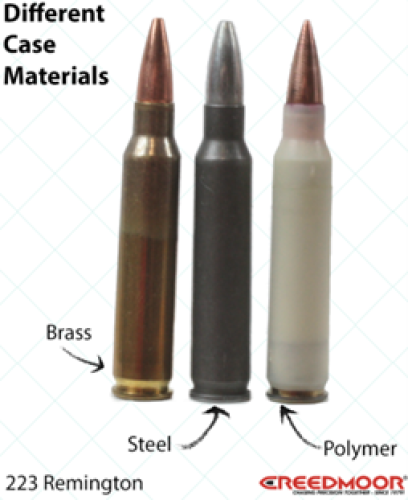The Cartridge Case
The Cartridge Case
The modern cartridge case is the heart and soul of ammunition. It is the single most expensive component to manufacture, and it is the only component that is completely reusable. Proper care of the cartridge case is critical if you are to produce safe, accurate ammunition. Cartridge cases were first introduced in the late 1500’s, consisting mainly of black powder and a bullet wrapped tightly in paper. The brass cartridge case, consisting of primer, brass case, propellent charge, and bullet were not introduced until the early 19th century.
Cartridge brass, an alloy of 40% zinc and 60% copper, has long been used in the production of the cartridge case which has led to the common use of the word “Brass” to refer to cartridge cases. However, cartridge brass is not the only material used in the construction of ammunition cases. Aluminum, Steel, and Polymer cases are in common circulation though these alternate materials are generally single use and are not considered reloadable.
More recently, multipiece cases made from stainless steel, and other metals have been introduced to the market. These novel cartridge cases can withstand higher pressures, are lighter, and have longer life then their brass predecessors. Being relatively newcomers to the market, they are rare and the equipment needed to reload them is specialized. Due to the relative novelty of multipiece cases we will not be covering the reloading of these designs in this guide.
Since the term brass can either refer to the cartridge case or the material the case is manufactured from, manufacturers generally refer to cartridge cases that are unloaded as “shells” and loaded shells as cartridges. This parlance is different from what the common shooter uses thus we will refer to the cartridge case as “brass” even if it is made from alternative materials, or simply as a “case”.
From a distance the casual observer may simply think the brass cartridge case provides a convenient package to handle the bullet, powder and primer. That is only one of the four main functions. The others are as follows:
- It integrates the powder, primer, bullet and propellent into a neat package that is easy and safe to handle.
- Aligns the bullet concentric to the chamber.
- Expands to fill the chamber creating a seal during firing, preventing the hot gas from escaping the chamber and blowing back into the action (and by extension the shooter's face.) After the pressure has dropped off the brass must spring back close to its original size to allow for the easy extraction of the spent cartridge.
- Acts as a heat sink removing a tremendous amount of heat from the chamber of a firearm when ejected.
Quality brass that is properly cared for can be reused for ten or more reloads. Considering the amount of abuse that brass takes this is an impressive feat. The life of brass is finite and depending on the condition of the firearm and the abuse the case is subjected to; it will eventually wear out. Inspecting brass should be a habit you get into every time you handle it; you should be looking for defects that may indicate it’s time to bin it.






